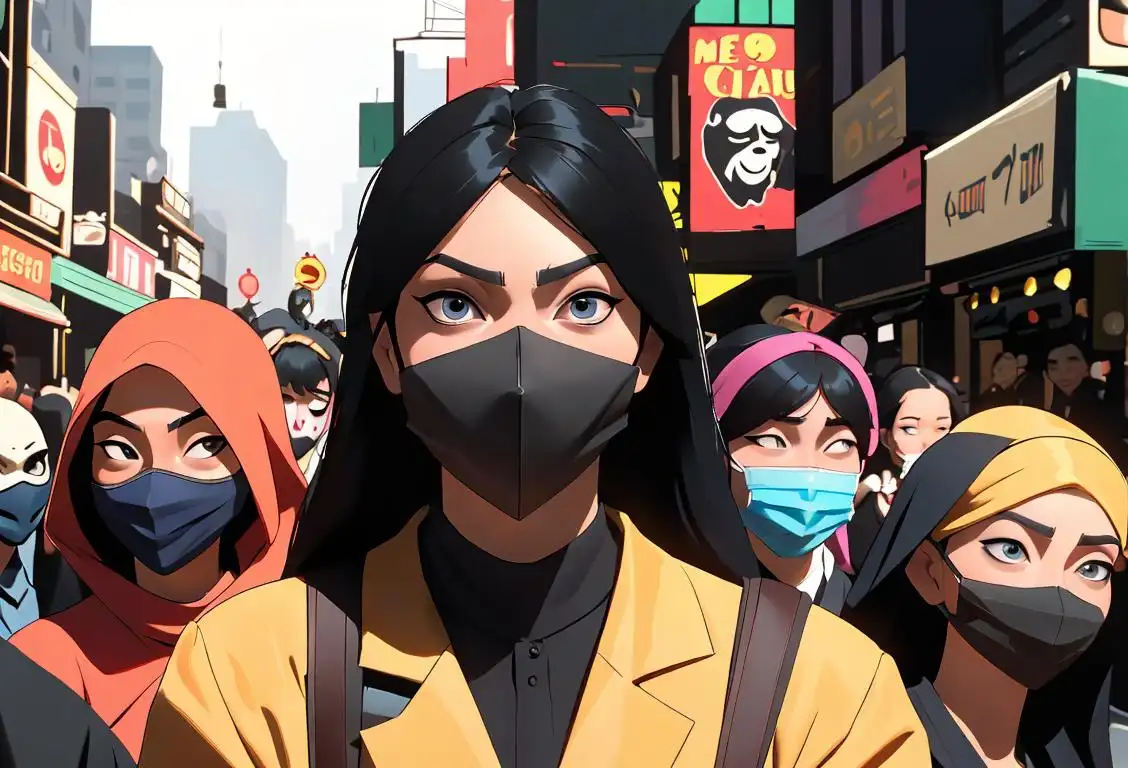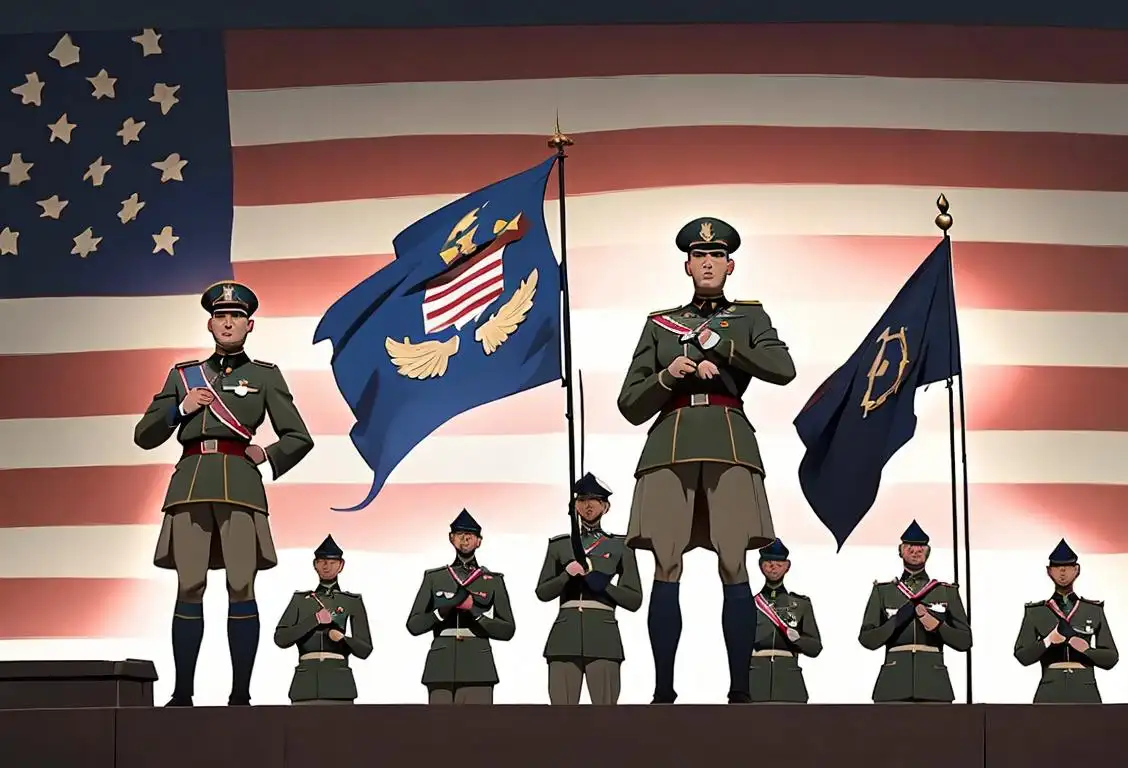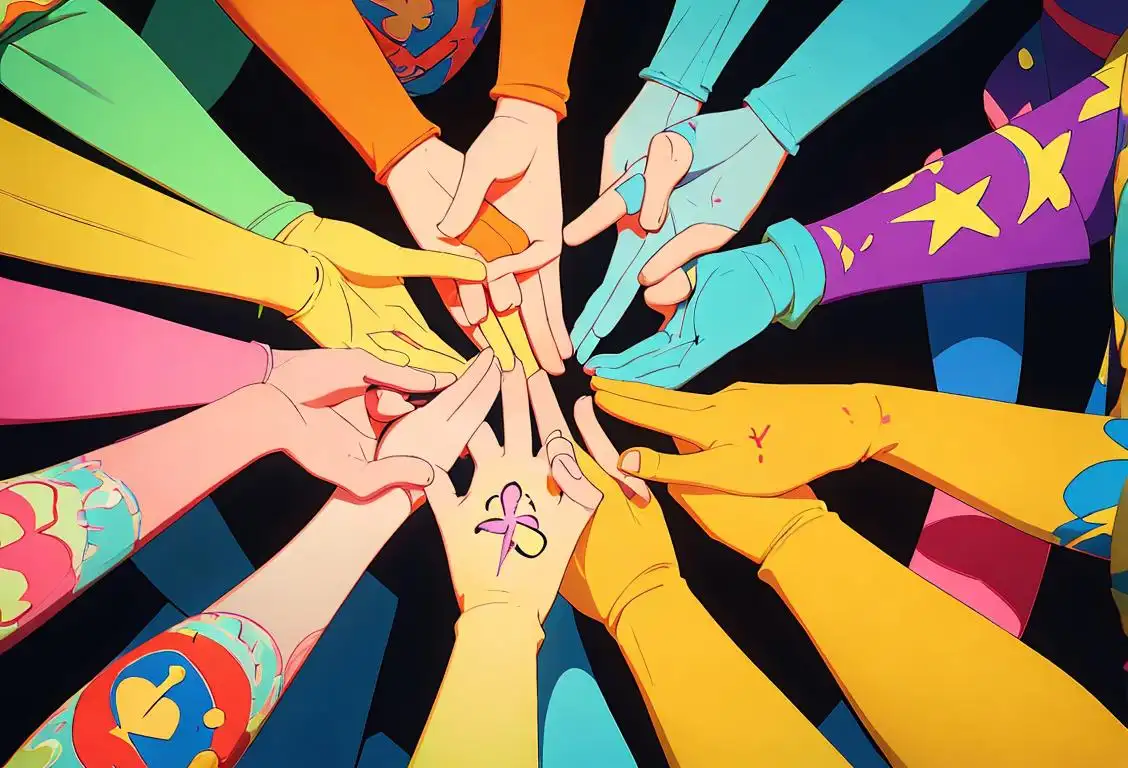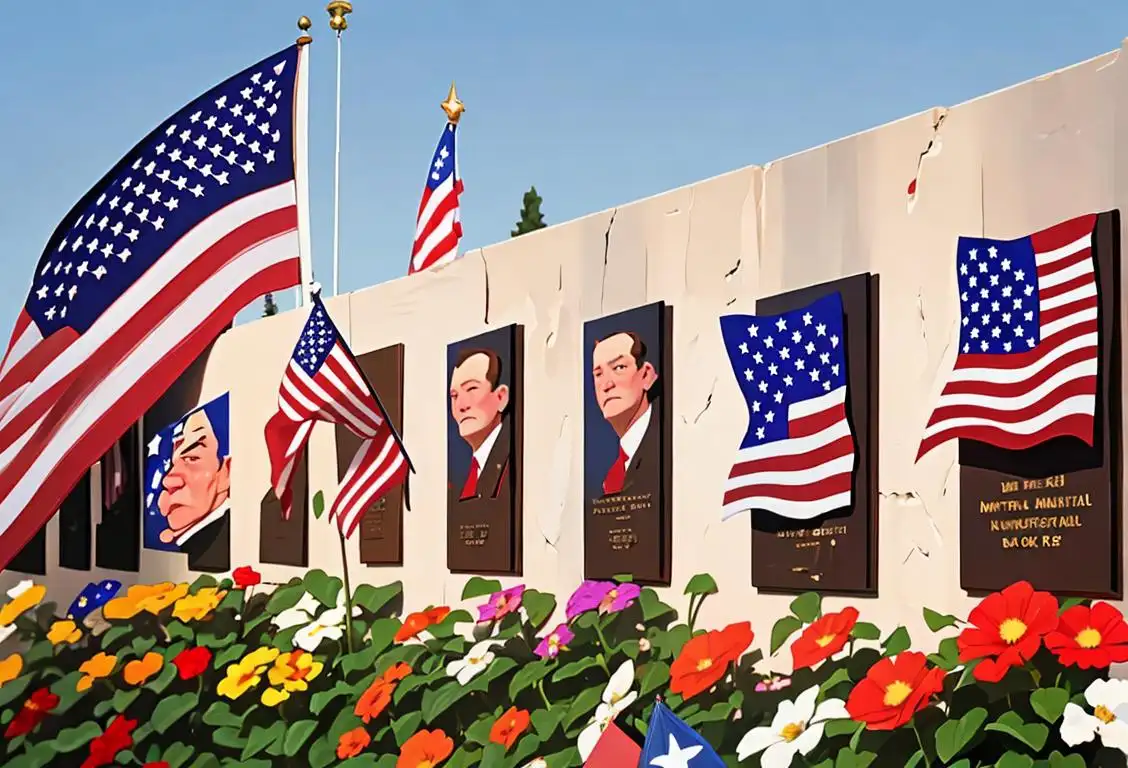National Wear A Mask Day

Happy National Wear a Mask Day! Who would have thought that a tiny piece of fabric would become such a hot topic of conversation? Well, it has, and now we have a whole day dedicated to encouraging everyone to embrace the safety and style of wearing masks. So, grab your favorite mask and let's dive into the internet history of National Wear a Mask Day!
When is Wear A Mask Day?
It's national wear a mask day on the 3rd July.
The Birth of National Wear a Mask Day
On this day, we celebrate the importance of wearing masks to protect ourselves and others. The origins of National Wear a Mask Day can be traced back to the challenges we faced during the COVID-19 pandemic. As the virus spread worldwide, health experts emphasized the need for mask-wearing as an effective measure to prevent transmission.
With the rise of social media and the #MaskUp movement, people started sharing their mask-wearing selfies and encouraging others to do the same. The internet became a hub of mask-related information, from DIY mask tutorials to creative mask designs.
In recognition of the significant role masks play in public health, National Wear a Mask Day was established. It serves as a powerful reminder to prioritize safety and community well-being. So, whether you prefer a simple surgical mask or a decorative cloth mask, this day is all about showing off your masked style while staying protected.
Mask-Wearing Through the Internet Ages
The internet has not only provided us with countless cat videos and funny memes, but it has also shaped the way we perceive and embrace mask-wearing. Let's take a journey through the internet ages and see how mask culture evolved:
The Myspace Era
Back in the early 2000s, MySpace ruled the internet, and Top 8 was the ultimate popularity gauge. While masks weren't a common sight on MySpace profiles, courageous pioneers did rock mask selfies as a fashion statement. Who knows, maybe they were just preparing for the future?
The Rise of Facebook
As Facebook rose to prominence, so did the trend of sharing everything with your entire friends list. When the H1N1 flu outbreak hit in 2009, mask selfies flooded Facebook news feeds. Some people used it as an opportunity to flex their creativity by showcasing handmade masks adorned with glitter and feathers. Others opted for the classic surgical mask look.
The Instagram Era
Welcome to the era of filters, influencers, and the perfect #OOTD (Outfit of the Day). Instagram became the go-to platform for showcasing fashion, and masks were no exception. Suddenly, mask-wearing transformed into a photo-worthy moment. People started matching their masks to their outfits, creating eye-catching ensembles.
Let's Celebrate!
As National Wear a Mask Day approaches, it's time to plan how you'll make a statement with your protected face. Use this day to spread awareness about the importance of mask-wearing and share your masked selfies with the world. Let's turn wearing masks into a stylish, community-building activity! Remember, it's not just about protecting yourself; it's also about caring for the well-being of your loved ones and those around you. So, mask up and embrace the mask-wearing culture!
History behind the term 'Wear A Mask'
1665
The Plague Doctor Mask
In the year 1665, during the height of the bubonic plague (also known as the Black Death) in Europe, the concept of wearing a mask for protection against diseases first emerged. Plague doctors, who were physicians tasked with treating plague victims, donned a unique beaked mask as part of their protective gear. This mask contained aromatic substances such as herbs and spices, which they believed would purify the air they breathed.
1918
The Spanish Flu Pandemic
During the Spanish Flu pandemic, which lasted from 1918 to 1919, wearing masks became a common sight in many countries. This highly contagious virus had a death toll of millions worldwide, and people realized that wearing masks could help prevent its spread. Masks were made from gauze or cloth and were often tied around the head or secured with elastic bands.
1667
The Birth of Wear a Mask
In 1667, the term 'wear a mask' first emerged in the English language. The word 'mask' originated from the Middle French word 'masque' meaning a covering for the face. Initially, wearing masks was associated with theater and masquerade balls, where individuals would don elaborate masks to conceal their identities and assume different personas.
1905
The Use of Masks in Theater
In 1905, the term 'wear a mask' gained popularity as a result of its association with the theater. In theatrical performances, actors often wear masks as part of their costumes to portray different characters or emotions. Masks in theater provide an enhanced way of conveying expressions and engage the audience in a more profound manner. This usage of masks set the foundation for the later significance of the term.
500 BCE
Ancient Origins
The concept of wearing masks has been traced back to ancient civilizations, with evidence of mask-wearing dating as far back as 500 BCE. In ancient Greek theater, actors wore masks to portray different characters and emotions. These masks helped amplify their expressions and make their performances more visible to the audience. Masks were also used in ancient religious ceremonies and rituals to represent gods and spirits.
1910
The Origins of the Mask
In 1910, the term 'wear a mask' gained prominence as a result of the Spanish Flu, one of the deadliest pandemics in history. People started wearing masks to protect themselves from the highly contagious virus, which claimed millions of lives worldwide. The awareness of the importance of wearing a mask to prevent the spread of diseases began to grow during this time.
1665
The Plague Doctors
In 1665, during the outbreak of the bubonic plague in Europe, physicians known as Plague Doctors wore a mask as a form of protective gear. These masks featured a long, bird-like beak filled with aromatic substances like herbs, spices, and vinegar. The scented beak was believed to protect the wearer from foul odors and diseases by filtering the air they breathed.
1960s
Air Pollution Concerns
In the 1960s, as air pollution became a significant issue in many industrialized cities, people started wearing masks to protect themselves from harmful pollutants. These masks were often made from paper or fabric and were not highly effective at filtering out fine particulate matter. Still, they symbolized public concern for improving air quality.
1860s
The Surgical Mask
Fast forward to the 1860s, and the concept of wearing masks for medical purposes continued to evolve. Surgeons began wearing masks during surgeries to prevent potential infection by microorganisms. These early surgical masks were typically made from cloth and were primarily intended to protect the patient from any potential germs carried by the surgeon.
1347
The Black Death
During the outbreak of the Black Death in Europe, which ravaged the continent from 1347 to 1351, physicians and plague doctors began wearing beaked masks filled with aromatic herbs. These masks, known as 'plague masks' or 'beak masks,' were believed to protect against the foul odors thought to spread the disease. Although the beak masks did not provide effective protection against the plague, they became a symbol of the epidemic and the fear associated with it.
1878
Masks for Protection
In 1878, during a severe outbreak of influenza in France, the concept of wearing masks for protection against contagious diseases gained prominence. Surgeons and healthcare workers began wearing masks to shield themselves and their patients from airborne germs. This marked the first instance of 'wear a mask' being associated with healthcare and public health measures.
1897
The Invention of the Surgical Mask
In 1897, a German surgeon named Paul Berger invented the first surgical mask. His mask consisted of several layers of gauze to provide a barrier against bacteria and prevent the spread of infection during surgeries. Berger's invention revolutionized the medical field and was widely adopted by healthcare professionals.
1918
The Spanish Flu Pandemic
The term 'wear a mask' gained widespread attention during the Spanish Flu pandemic in 1918. As the deadly virus spread rapidly, health officials urged the public to wear masks in an attempt to reduce transmission rates. Governments even made it mandatory to wear masks in public places during the peak of the pandemic. The phrase became a common reminder for individuals to protect themselves and others, contributing to its cultural impact.
1945
Mask-wearing during World War II
During World War II, the phrase 'wear a mask' took on a new meaning as it became associated with the use of gas masks by military personnel. Gas masks were used to protect soldiers from the harmful effects of chemical weapons, providing them with a literal mask against danger. This period further emphasized the significance of wearing protective masks, even in the face of great peril.
1918
The Spanish Flu Pandemic
The widespread use of masks took a significant leap during the Spanish Flu pandemic in 1918. With the highly contagious virus causing millions of deaths worldwide, governments and health authorities recommended or mandated the use of masks as a preventive measure. The general population embraced the idea, and in many places, individuals were required to wear masks in public spaces.
2003
SARS Outbreak
During the outbreak of Severe Acute Respiratory Syndrome (SARS) in 2003, wearing masks gained even more prominence. SARS, caused by a type of coronavirus, had a high fatality rate and spread rapidly. Wearing masks became an essential preventive measure in affected areas, especially in East Asian countries where mask-wearing practices were already part of their culture.
1624
Medical Use
In the early 17th century, during the bubonic plague outbreaks in Europe, physicians started wearing beaked masks with glass eyepieces and air filtration systems. These masks, known as 'plague masks' or 'plague doctor masks,' were designed to protect medical practitioners from inhaling infectious particles. The terrifying appearance of the masks, combined with their perceived effectiveness, made them an iconic symbol of disease and medical treatment.
1918
The Spanish Flu Pandemic
During the Spanish Flu pandemic in 1918, wearing masks became a common practice to limit the spread of the highly contagious virus. Authorities implemented mask-wearing mandates in various cities and urged citizens to wear masks in public spaces. The masks, often made of multiple layers of fabric, were believed to prevent the transmission of respiratory droplets and protect individuals from infection.
1970
Mask-wearing as a Cultural Statement
In the 1970s, the emergence of counterculture movements and artistic expression brought mask-wearing into the realm of cultural symbolism. Masks became powerful tools for self-expression, often used in protests or performances to challenge societal norms or conceal one's identity. This period marked a shift in the perception of masks from primarily being used for protection to becoming a form of personal statement or political expression.
2020
COVID-19 and Mask Mandates
The year 2020 witnessed the term 'wear a mask' reaching unprecedented levels of global significance due to the COVID-19 pandemic. As the novel coronavirus quickly engulfed the world, health authorities and governments once again stressed the importance of wearing masks in public spaces to help prevent the spread of the virus. The phrase became a rallying cry to prioritize public health and safety, leading to the widespread adoption of mask-wearing worldwide.
1918
The Spanish Flu Pandemic
One of the most impactful moments in the history of 'wear a mask' came during the devastating Spanish Flu pandemic of 1918. Governments, organizations, and individuals worldwide recognized the importance of wearing masks as a preventive measure against the virus. Mask mandates were issued in many cities, with penalties for non-compliance. The widespread use of masks became a symbol of unity and collective effort in combating the deadly disease.
1940s
Masks in Film and Pop Culture
During the 1940s, the significance of masks expanded beyond theater and healthcare. Masks became an integral part of popular culture through movies, particularly in the superhero genre. Iconic characters like Batman, Spider-Man, and Zorro donned masks as part of their crime-fighting personas. The concept of 'wear a mask' became synonymous with heroic identities and concealed alter egos.
1972
The Smog Mask
In 1972, face masks gained popularity as protection against air pollution and smog. As urban areas faced increasing pollution levels, people turned to masks with air filters to breathe cleaner air. These masks became particularly prevalent in heavily industrialized cities, where the impact of pollution on public health was a growing concern.
2020
COVID-19 Pandemic
In 2020, the world experienced the COVID-19 pandemic caused by the novel coronavirus SARS-CoV-2. Wearing masks became a global phenomenon as governments and health organizations recommended their usage to slow down the spread of the virus. Masks were primarily worn to prevent asymptomatic individuals from unknowingly transmitting the virus to others. The widespread adoption of mask-wearing sparked debates and cultural shifts surrounding individual responsibility, public health, and personal freedoms.
1910
Protection against Pollution
As industrialization progressed, pollution became a growing concern in many cities around the world. In response, in 1910, a widespread practice called 'smoke abatement' emerged, where people wore masks to protect themselves from the harmful effects of air pollution. These early masks were made of cloth or gauze and were not particularly effective against fine particles. Nonetheless, they marked the beginning of public awareness and individual efforts to mitigate the impact of pollution.
2020
The Mask as a Global Phenomenon
In 2020, the world faced the outbreak of the COVID-19 pandemic, and 'wear a mask' once again became a rallying cry. Governments and health organizations worldwide recommended or mandated mask-wearing as a crucial measure to curb the spread of the virus. It became a global phenomenon, demonstrating the interconnectedness of humanity and the shared responsibility to protect one another. Wearing a mask evolved from a cultural statement to an act of solidarity and empathy in the fight against a common enemy.
2020
COVID-19 and Mask Wearing
The year 2020 brought about a new chapter in the history of mask-wearing. The world faced the COVID-19 pandemic caused by the novel coronavirus. As scientists learned more about the virus's modes of transmission, wearing masks became a key strategy to reduce the spread of the virus. Governments and health organizations worldwide recommended or mandated mask usage in public settings, leading to a surge in mask production and usage. Mask wearing became a symbol of personal and collective responsibility in combating the pandemic.
2020
The COVID-19 Pandemic
The defining moment in the modern history of 'wear a mask' was the global outbreak of COVID-19 in 2020. As the virus spread rapidly, wearing masks became a crucial preventive measure recommended by health authorities worldwide. Governments implemented mask mandates and public awareness campaigns to encourage mask usage. Masks became a symbol of responsibility and protection for oneself and others during the pandemic.
2020
The COVID-19 Pandemic
The year 2020 witnessed a global pandemic caused by the novel coronavirus (COVID-19). Wearing masks emerged as a crucial preventive measure against the transmission of the virus. Health organizations such as the World Health Organization (WHO) and the Centers for Disease Control and Prevention (CDC) recommended mask-wearing in public settings to reduce the risk of respiratory droplet transmission. Cloth masks, surgical masks, and N95 respirators became everyday essentials for individuals worldwide.
2020
COVID-19 Pandemic
The COVID-19 pandemic, caused by the novel coronavirus, drastically changed the perception and usage of masks worldwide. In 2020, wearing masks became a crucial preventive measure to reduce the spread of the virus. Governments and health organizations encouraged or mandated mask-wearing in public settings to protect individuals and prevent the transmission of respiratory droplets. This collective effort to 'wear a mask' became a symbol of solidarity and responsible action in the face of a global crisis.
Did you know?
Did you know that the oldest known masks date back to over 9,000 years ago? They were found in the West Bank and were made from stone. Talk about a timeless fashion accessory!Tagged
awareness fun loved onesFirst identified
2nd July 2020Most mentioned on
3rd July 2020Total mentions
13Other days
Compliment Day
Cheese Pizza Day
Pumpkin Day
Medal Of Honor Day
Guac Day
Foundation Day
Suicide Prevention Day
Memorial Day
Cancer Survivors Day
Bacon Day









